clutch Alfa Romeo Giulietta 2014 Owner's Manual
[x] Cancel search | Manufacturer: ALFA ROMEO, Model Year: 2014, Model line: Giulietta, Model: Alfa Romeo Giulietta 2014Pages: 280, PDF Size: 6.65 MB
Page 6 of 280
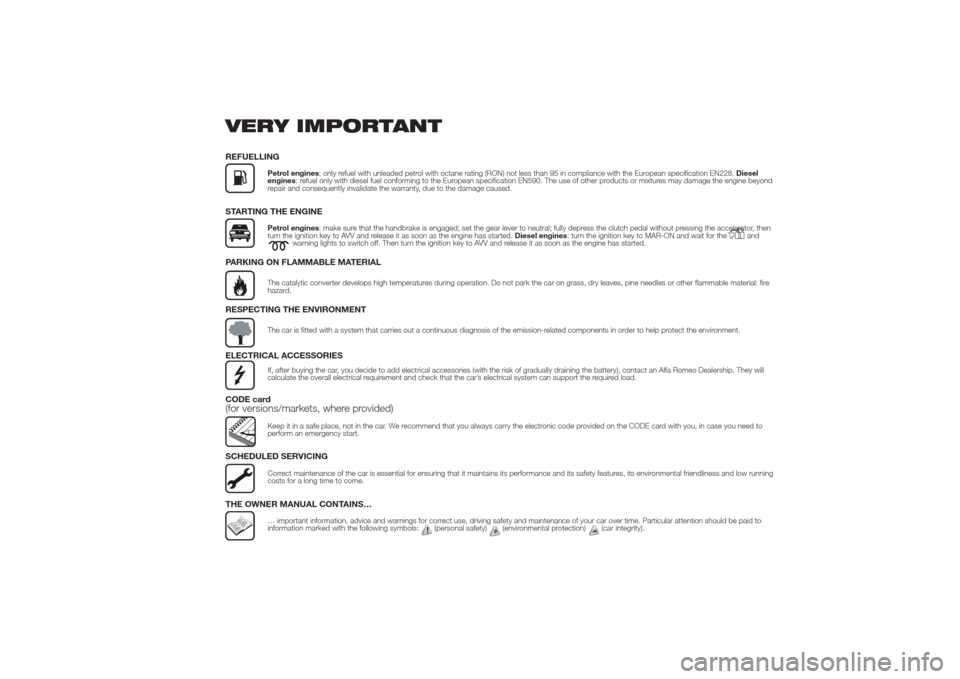
VERY IMPORTANTREFUELLING
Petrol engines: only refuel with unleaded petrol with octane rating (RON) not less than 95 in compliance with the European specification EN228.Diesel
engines: refuel only with diesel fuel conforming to the European specification EN590. The use of other products or mixtures may damage the engine beyond
repair and consequently invalidate the warranty, due to the damage caused.
STARTING THE ENGINE
Petrol engines: make sure that the handbrake is engaged; set the gear lever to neutral; fully depress the clutch pedal without pressing the accelerator, then
turn the ignition key to AVV and release it as soon as the engine has started.Diesel engines: turn the ignition key to MAR-ON and wait for the
and
warning lights to switch off. Then turn the ignition key to AVV and release it as soon as the engine has started.
PARKING ON FLAMMABLE MATERIAL
The catalytic converter develops high temperatures during operation. Do not park the car on grass, dry leaves, pine needles or other flammable material: fire
hazard.
RESPECTING THE ENVIRONMENT
The car is fitted with a system that carries out a continuous diagnosis of the emission-related components in order to help protect the environment.
ELECTRICAL ACCESSORIES
If, after buying the car, you decide to add electrical accessories (with the risk of gradually draining the battery), contact an Alfa Romeo Dealership. They will
calculate the overall electrical requirement and check that the car’s electrical system can support the required load.
CODE card(for versions/markets, where provided)
Keep it in a safe place, not in the car. We recommend that you always carry the electronic code provided on the CODE card with you, in case you need to
perform an emergency start.
SCHEDULED SERVICING
Correct maintenance of the car is essential for ensuring that it maintains its performance and its safety features, its environmental friendliness and low running
costs for a long time to come.
THE OWNER MANUAL CONTAINS…
… important information, advice and warnings for correct use, driving safety and maintenance of your car over time. Particular attention should be paid to
information marked with the following symbols: (personal safety) (environmental protection) (car integrity).
Page 45 of 280

CRUISE CONTROL(for versions/markets, where provided)
IN BRIEF
This is an electronically controlled
driving assistance device that allows
the desired car speed to be
maintained, without having to press
the accelerator pedal. This device
can be used at a speed above
30 km/h on long stretches of dry,
straight roads with few variations
(e.g. motorways).
The use of this device on extra-urban
roads with traffic is not therefore
recommended. Do not use it in town.
TURNING THE DEVICE
ON
Turn ring nut A fig. 34 to ON.The device cannot be engaged in 1
stor
reverse gear: it is advisable to engage
it in 5
thgear or higher.
When travelling downhill with the device
engaged, the car may slightly exceed
the stored speed.
Thewarning light and, for
versions/markets, where provided,
message on the display are switched
on to indicate activation.
STORING THE CAR
SPEED
Proceed as follows:
❒turn ring nut A fig. 34 to ON and
press the accelerator to reach the
required speed;
❒move the stalk upwards (+) for at
least 1 second, then release it: the
car speed is now stored and you can
therefore release the accelerator.
If needed (when overtaking for
instance), you can accelerate simply by
pressing the accelerator; when you
release the pedal, the car goes back to
the speed stored previously.RESTORING THE
MEMORISED SPEED
If the device has been disengaged by
pressing the brake or clutch pedal, the
stored speed can be reset as follows:
❒accelerate gradually until a speed
approaching the one stored is
reached;
❒engage the gear selected at the time
that the speed was stored;
❒press the RES button (B fig. 34).
INCREASING THE
MEMORISED SPEED
This can be done in two ways:
❒by pressing the accelerator and
storing the new speed reached
or
❒by moving the stalk upwards (+) until
the new speed, which will be stored
automatically, is reached.
Each movement of the stalk
corresponds to an increase in speed of
about 1 km/h, while keeping the stalk
held upwards will continuously increase
the speed.
34
A0K0559
41
Page 46 of 280
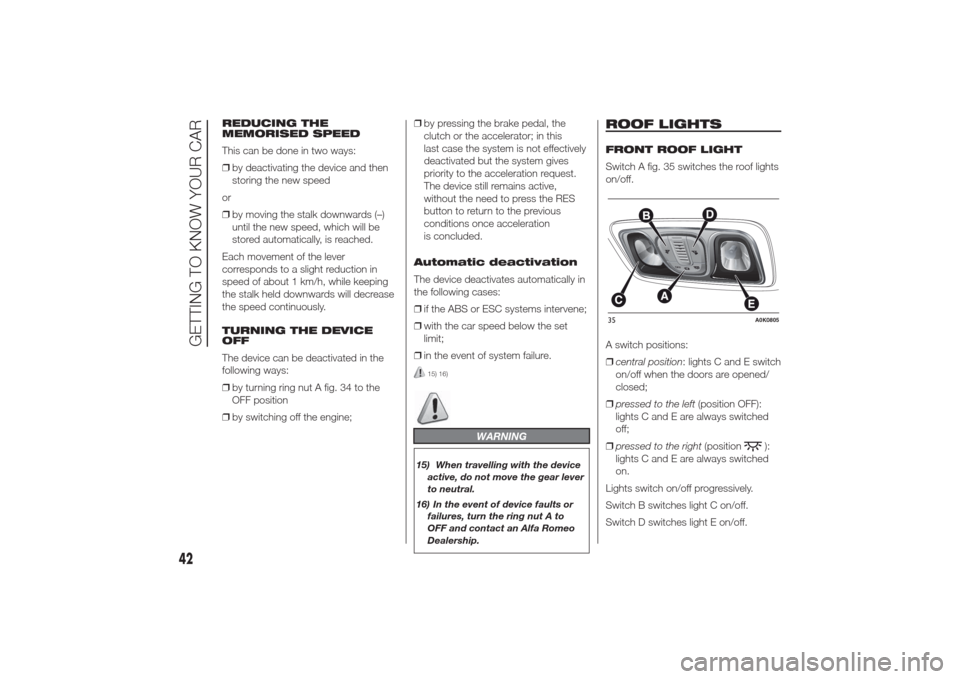
REDUCING THE
MEMORISED SPEED
This can be done in two ways:
❒by deactivating the device and then
storing the new speed
or
❒by moving the stalk downwards (–)
until the new speed, which will be
stored automatically, is reached.
Each movement of the lever
corresponds to a slight reduction in
speed of about 1 km/h, while keeping
the stalk held downwards will decrease
the speed continuously.
TURNING THE DEVICE
OFF
The device can be deactivated in the
following ways:
❒by turning ring nut A fig. 34 to the
OFF position
❒by switching off the engine;❒by pressing the brake pedal, the
clutch or the accelerator; in this
last case the system is not effectively
deactivated but the system gives
priority to the acceleration request.
The device still remains active,
without the need to press the RES
button to return to the previous
conditions once acceleration
is concluded.
Automatic deactivation
The device deactivates automatically in
the following cases:
❒if the ABS or ESC systems intervene;
❒with the car speed below the set
limit;
❒in the event of system failure.
15) 16)
WARNING
15) When travelling with the device
active, do not move the gear lever
to neutral.
16) In the event of device faults or
failures, turn the ring nut A to
OFF and contact an Alfa Romeo
Dealership.
ROOF LIGHTSFRONT ROOF LIGHT
Switch A fig. 35 switches the roof lights
on/off.
A switch positions:
❒central position: lights C and E switch
on/off when the doors are opened/
closed;
❒pressed to the left(position OFF):
lights C and E are always switched
off;
❒pressed to the right(position
):
lights C and E are always switched
on.
Lights switch on/off progressively.
Switch B switches light C on/off.
Switch D switches light E on/off.
35
A0K0805
42
GETTING TO KNOW YOUR CAR
Page 77 of 280

START&STOP
SYSTEM(for versions/markets, where provided)
IN BRIEF
The Start&Stop system automatically
stops the engine each time the car
is stationary and starts it again when
the driver wants to move off.
In this way, the efficiency of the car is
increased, by reducing consumption,
emissions of harmful gases and
noise pollution.
OPERATING MODES
Engine stopping mode
With the car stopped, the engine stops
with gearbox in neutral and clutch
pedal released.
NOTE The engine can only be stopped
automatically after exceeding about
10 km/h, to prevent the engine from
being repeatedly stopped when driving
at walking pace.
The
fig. 81 symbol appears on the
display when the engine stops.Restarting the engine
Press the clutch pedal to restart the
engine.
SYSTEM MANUAL
ACTIVATION/
DEACTIVATION
To activate/deactivate the system
manually, press the
button located
on the central tunnel fig. 82.Start&Stop system
activation
A message will be displayed when the
Start&Stop system is activated. In
this condition, the LED on the button
is off.
Turning the Start&Stop
off
❒Versions with multifunction display:a
message is displayed when the
Start&Stop system is deactivated.
❒Versions with reconfigurable
multifunction display:the
symbol
is displayed + a message when
the Start&Stop system is
deactivated.
The LED on the button
switches on
when the system is deactivated.
81
A0K0163
82
A0K0613
73
Page 78 of 280
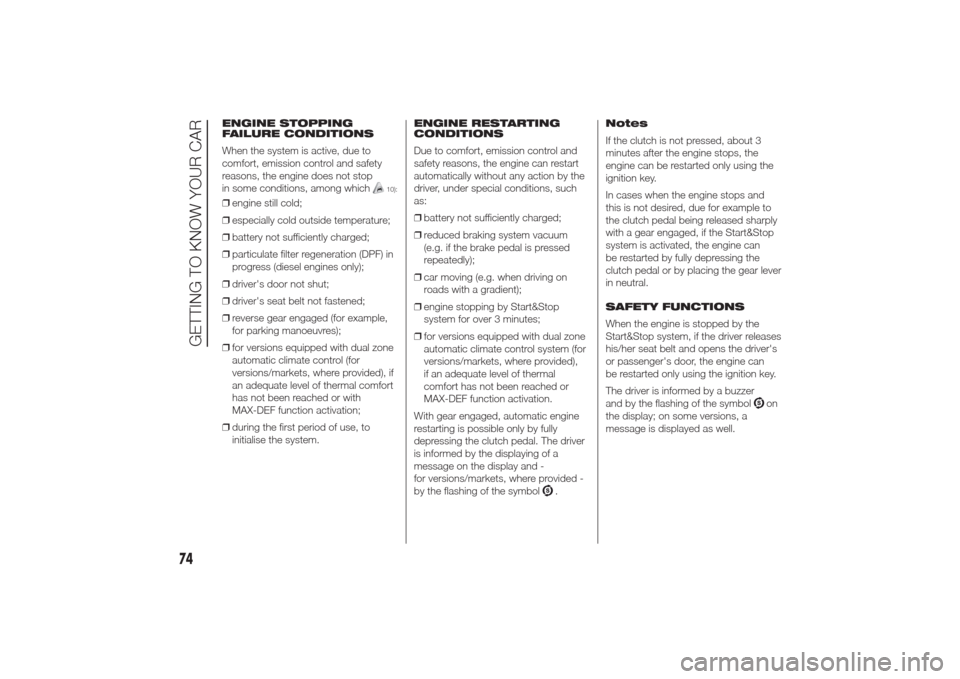
ENGINE STOPPING
FAILURE CONDITIONS
When the system is active, due to
comfort, emission control and safety
reasons, the engine does not stop
in some conditions, among which
10):
❒engine still cold;
❒especially cold outside temperature;
❒battery not sufficiently charged;
❒particulate filter regeneration (DPF) in
progress (diesel engines only);
❒driver's door not shut;
❒driver's seat belt not fastened;
❒reverse gear engaged (for example,
for parking manoeuvres);
❒for versions equipped with dual zone
automatic climate control (for
versions/markets, where provided), if
an adequate level of thermal comfort
has not been reached or with
MAX-DEF function activation;
❒during the first period of use, to
initialise the system.ENGINE RESTARTING
CONDITIONS
Due to comfort, emission control and
safety reasons, the engine can restart
automatically without any action by the
driver, under special conditions, such
as:
❒battery not sufficiently charged;
❒reduced braking system vacuum
(e.g. if the brake pedal is pressed
repeatedly);
❒car moving (e.g. when driving on
roads with a gradient);
❒engine stopping by Start&Stop
system for over 3 minutes;
❒for versions equipped with dual zone
automatic climate control system (for
versions/markets, where provided),
if an adequate level of thermal
comfort has not been reached or
MAX-DEF function activation.
With gear engaged, automatic engine
restarting is possible only by fully
depressing the clutch pedal. The driver
is informed by the displaying of a
message on the display and -
for versions/markets, where provided -
by the flashing of the symbol
.Notes
If the clutch is not pressed, about 3
minutes after the engine stops, the
engine can be restarted only using the
ignition key.
In cases when the engine stops and
this is not desired, due for example to
the clutch pedal being released sharply
with a gear engaged, if the Start&Stop
system is activated, the engine can
be restarted by fully depressing the
clutch pedal or by placing the gear lever
in neutral.
SAFETY FUNCTIONS
When the engine is stopped by the
Start&Stop system, if the driver releases
his/her seat belt and opens the driver's
or passenger's door, the engine can
be restarted only using the ignition key.
The driver is informed by a buzzer
and by the flashing of the symbol
on
the display; on some versions, a
message is displayed as well.
74
GETTING TO KNOW YOUR CAR
Page 158 of 280
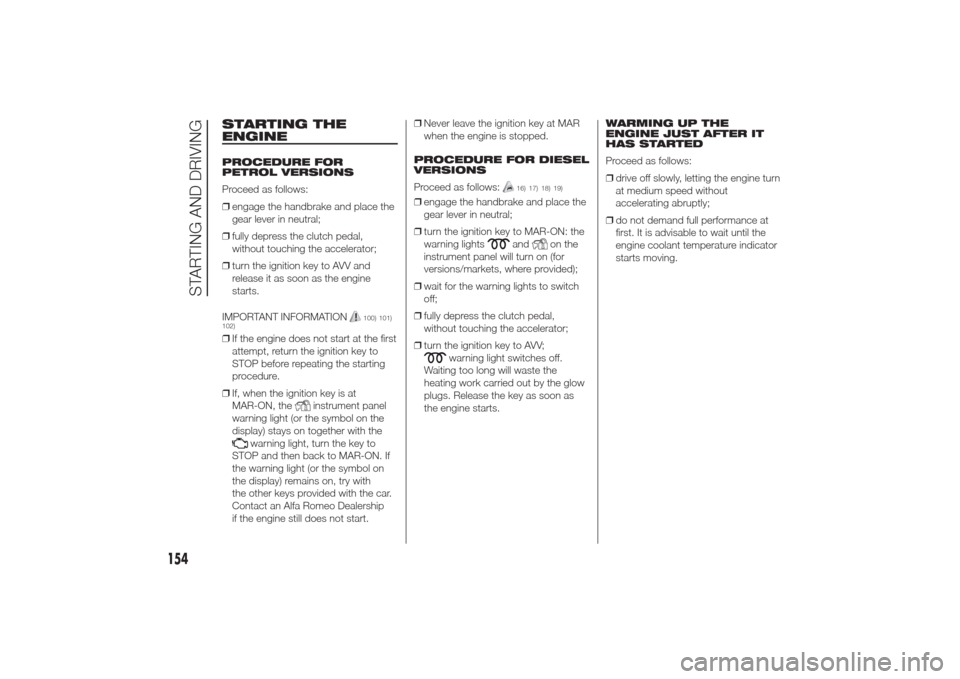
STARTING THE
ENGINEPROCEDURE FOR
PETROL VERSIONS
Proceed as follows:
❒engage the handbrake and place the
gear lever in neutral;
❒fully depress the clutch pedal,
without touching the accelerator;
❒turn the ignition key to AVV and
release it as soon as the engine
starts.
IMPORTANT INFORMATION
100) 101)
102)
❒If the engine does not start at the first
attempt, return the ignition key to
STOP before repeating the starting
procedure.
❒If, when the ignition key is at
MAR-ON, the
instrument panel
warning light (or the symbol on the
display) stays on together with the
warning light, turn the key to
STOP and then back to MAR-ON. If
the warning light (or the symbol on
the display) remains on, try with
the other keys provided with the car.
Contact an Alfa Romeo Dealership
if the engine still does not start.❒Never leave the ignition key at MAR
when the engine is stopped.
PROCEDURE FOR DIESEL
VERSIONS
Proceed as follows:
16)
❒engage the handbrake and place the
gear lever in neutral;
❒turn the ignition key to MAR-ON: the
warning lights
and
on the
instrument panel will turn on (for
versions/markets, where provided);
❒wait for the warning lights to switch
off;
❒fully depress the clutch pedal,
without touching the accelerator;
❒turn the ignition key to AVV;
warning light switches off.
Waiting too long will waste the
heating work carried out by the glow
plugs. Release the key as soon as
the engine starts.WARMING UP THE
ENGINE JUST AFTER IT
HAS STARTED
Proceed as follows:
❒drive off slowly, letting the engine turn
at medium speed without
accelerating abruptly;
❒do not demand full performance at
first. It is advisable to wait until the
engine coolant temperature indicator
starts moving.
154
STARTING AND DRIVING
1)1)
19) 78
Page 160 of 280

HANDBRAKE
To engage it, pull lever A fig. 126
upwards until the car is secured.
When the handbrake is engaged and
the ignition key is at MAR-ON, the
warning light will switch on in the
instrument panel.
To release it, raise lever A slightly, hold
down button B and lower the lever:
the
warning light on the instrument
panel switches off.
103) 104)
IMPORTANT Carry out these
manoeuvres with the brake pedal
pressed.
IMPORTANT For cars equipped with a
front armrest, lift it up to ensure that
it does not interfere with the action of
the handbrake.
WARNING
103) Never leave children
unattended in the car. Always
remove the key from the ignition
device when leaving the car and
take it with you.
104) The car must be locked after a
few clicks of the parking brake: if
this is not so, contact an Alfa
Romeo Dealership to have it
adjusted. Always park the car
safely as indicated by the
Highway Code and as described
above.
USING THE
GEARBOXTo engage the gears, press the clutch
pedal fully and shift the gear lever
into one of the required positions (the
diagram for gear engagement is shown
on the knob of the lever
105)).
To engage the 6
thgear, operate the
lever by pressing it towards the right in
order to avoid engaging the 4th gear
by mistake. The same applies to the
shift from 6
thto 5
thgear.
20)
To engage reverse gear (R) from the
neutral position, lift up ring A fig. 127
and simultaneously move the lever
to the left and then forwards.
IMPORTANT Reverse can only be
engaged when the car is completely
stationary.
126
A0K0615
127
A0K0616
156
STARTING AND DRIVING
Page 161 of 280
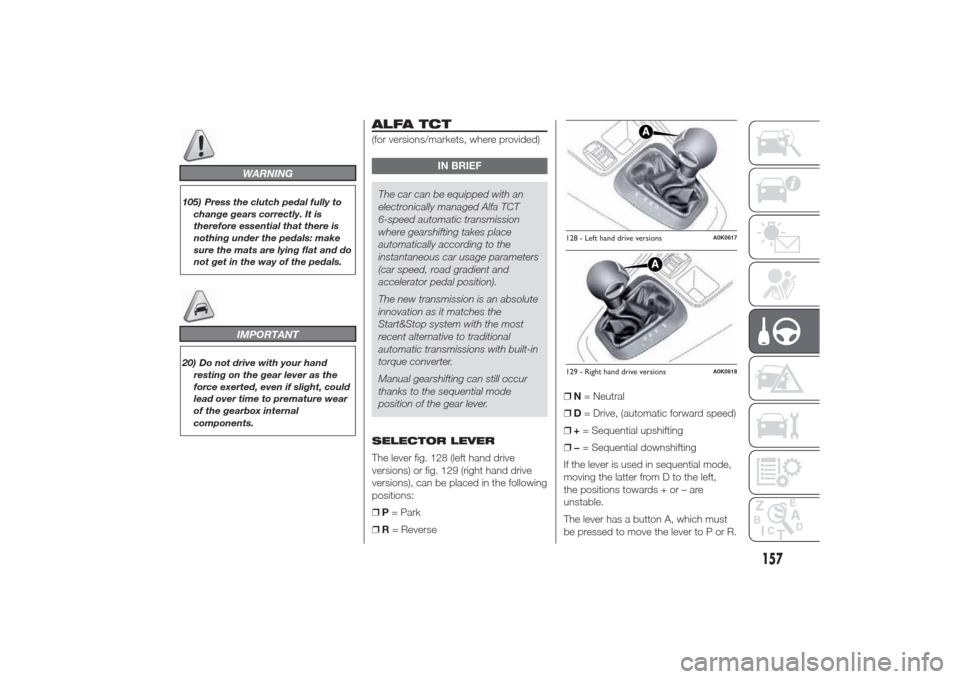
WARNING
105) Press the clutch pedal fully to
change gears correctly. It is
therefore essential that there is
nothing under the pedals: make
sure the mats are lying flat and do
not get in the way of the pedals.
IMPORTANT
20) Do not drive with your hand
resting on the gear lever as the
force exerted, even if slight, could
lead over time to premature wear
of the gearbox internal
components.
ALFA TCT(for versions/markets, where provided)
IN BRIEF
The car can be equipped with an
electronically managed Alfa TCT
6-speed automatic transmission
where gearshifting takes place
automatically according to the
instantaneous car usage parameters
(car speed, road gradient and
accelerator pedal position).
The new transmission is an absolute
innovation as it matches the
Start&Stop system with the most
recent alternative to traditional
automatic transmissions with built-in
torque converter.
Manual gearshifting can still occur
thanks to the sequential mode
position of the gear lever.
SELECTOR LEVER
The lever fig. 128 (left hand drive
versions) or fig. 129 (right hand drive
versions), can be placed in the following
positions:
❒P= Park
❒R= Reverse❒N= Neutral
❒D= Drive, (automatic forward speed)
❒+= Sequential upshifting
❒−= Sequential downshifting
If the lever is used in sequential mode,
moving the latter from D to the left,
the positions towards + or – are
unstable.
The lever has a button A, which must
be pressed to move the lever to P or R.
128 - Left hand drive versions
A0K0617
129 - Right hand drive versions
A0K0618
157
Page 165 of 280
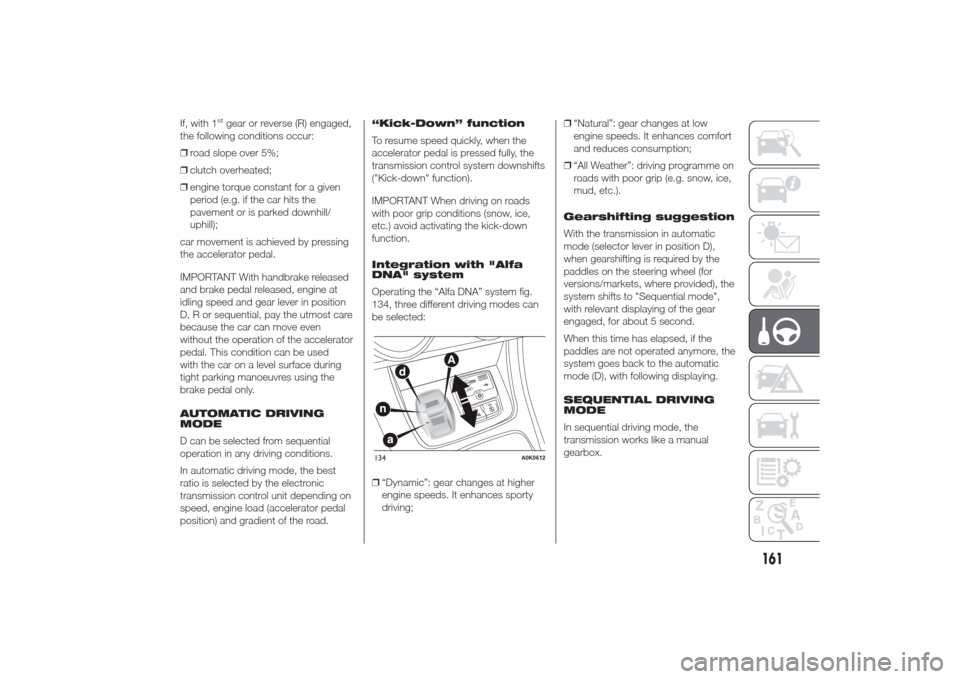
If, with 1
stgear or reverse (R) engaged,
the following conditions occur:
❒road slope over 5%;
❒clutch overheated;
❒engine torque constant for a given
period (e.g. if the car hits the
pavement or is parked downhill/
uphill);
car movement is achieved by pressing
the accelerator pedal.
IMPORTANT With handbrake released
and brake pedal released, engine at
idling speed and gear lever in position
D, R or sequential, pay the utmost care
because the car can move even
without the operation of the accelerator
pedal. This condition can be used
with the car on a level surface during
tight parking manoeuvres using the
brake pedal only.
AUTOMATIC DRIVING
MODE
D can be selected from sequential
operation in any driving conditions.
In automatic driving mode, the best
ratio is selected by the electronic
transmission control unit depending on
speed, engine load (accelerator pedal
position) and gradient of the road.“Kick-Down” function
To resume speed quickly, when the
accelerator pedal is pressed fully, the
transmission control system downshifts
("Kick-down" function).
IMPORTANT When driving on roads
with poor grip conditions (snow, ice,
etc.) avoid activating the kick-down
function.
Integration with "Alfa
DNA" system
Operating the “Alfa DNA” system fig.
134, three different driving modes can
be selected:
❒“Dynamic”: gear changes at higher
engine speeds. It enhances sporty
driving;❒“Natural”: gear changes at low
engine speeds. It enhances comfort
and reduces consumption;
❒“All Weather”: driving programme on
roads with poor grip (e.g. snow, ice,
mud, etc.).
Gearshifting suggestion
With the transmission in automatic
mode (selector lever in position D),
when gearshifting is required by the
paddles on the steering wheel (for
versions/markets, where provided), the
system shifts to "Sequential mode",
with relevant displaying of the gear
engaged, for about 5 second.
When this time has elapsed, if the
paddles are not operated anymore, the
system goes back to the automatic
mode (D), with following displaying.
SEQUENTIAL DRIVING
MODE
In sequential driving mode, the
transmission works like a manual
gearbox.
134
A0K0612
161
Page 167 of 280
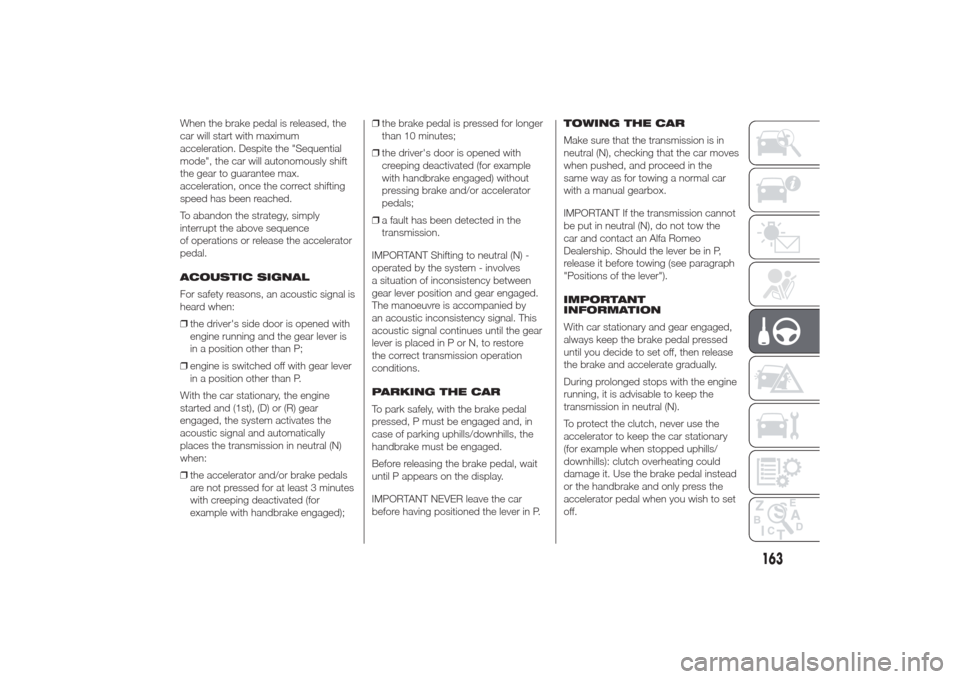
When the brake pedal is released, the
car will start with maximum
acceleration. Despite the "Sequential
mode", the car will autonomously shift
the gear to guarantee max.
acceleration, once the correct shifting
speed has been reached.
To abandon the strategy, simply
interrupt the above sequence
of operations or release the accelerator
pedal.
ACOUSTIC SIGNAL
For safety reasons, an acoustic signal is
heard when:
❒the driver's side door is opened with
engine running and the gear lever is
in a position other than P;
❒engine is switched off with gear lever
in a position other than P.
With the car stationary, the engine
started and (1st), (D) or (R) gear
engaged, the system activates the
acoustic signal and automatically
places the transmission in neutral (N)
when:
❒the accelerator and/or brake pedals
are not pressed for at least 3 minutes
with creeping deactivated (for
example with handbrake engaged);❒the brake pedal is pressed for longer
than 10 minutes;
❒the driver's door is opened with
creeping deactivated (for example
with handbrake engaged) without
pressing brake and/or accelerator
pedals;
❒a fault has been detected in the
transmission.
IMPORTANT Shifting to neutral (N) -
operated by the system - involves
a situation of inconsistency between
gear lever position and gear engaged.
The manoeuvre is accompanied by
an acoustic inconsistency signal. This
acoustic signal continues until the gear
lever is placed in P or N, to restore
the correct transmission operation
conditions.
PARKING THE CAR
To park safely, with the brake pedal
pressed, P must be engaged and, in
case of parking uphills/downhills, the
handbrake must be engaged.
Before releasing the brake pedal, wait
until P appears on the display.
IMPORTANT NEVER leave the car
before having positioned the lever in P.TOWING THE CAR
Make sure that the transmission is in
neutral (N), checking that the car moves
when pushed, and proceed in the
same way as for towing a normal car
with a manual gearbox.
IMPORTANT If the transmission cannot
be put in neutral (N), do not tow the
car and contact an Alfa Romeo
Dealership. Should the lever be in P,
release it before towing (see paragraph
"Positions of the lever").
IMPORTANT
INFORMATION
With car stationary and gear engaged,
always keep the brake pedal pressed
until you decide to set off, then release
the brake and accelerate gradually.
During prolonged stops with the engine
running, it is advisable to keep the
transmission in neutral (N).
To protect the clutch, never use the
accelerator to keep the car stationary
(for example when stopped uphills/
downhills): clutch overheating could
damage it. Use the brake pedal instead
or the handbrake and only press the
accelerator pedal when you wish to set
off.
163